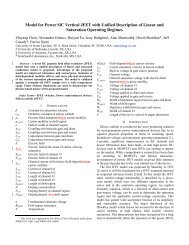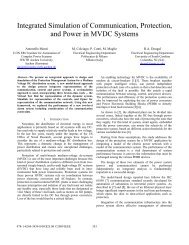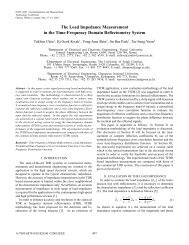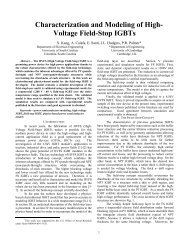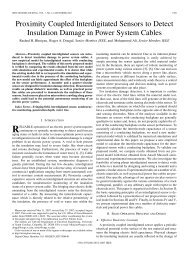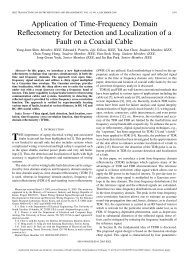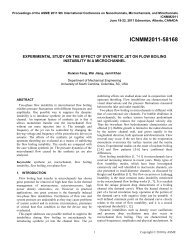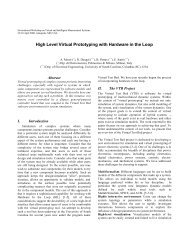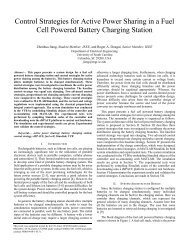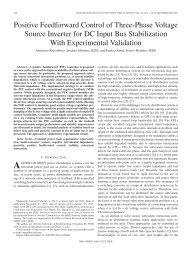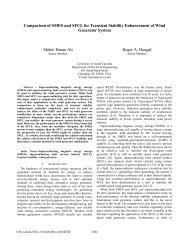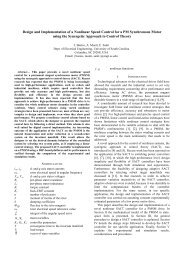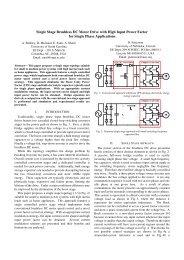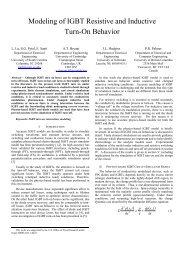Dynamic Performance of a SCARA Robot Manipulator With ...
Dynamic Performance of a SCARA Robot Manipulator With ...
Dynamic Performance of a SCARA Robot Manipulator With ...
Create successful ePaper yourself
Turn your PDF publications into a flip-book with our unique Google optimized e-Paper software.
206 IEEE TRANSACTIONS ON ROBOTICS, VOL. 25, NO. 1, FEBRUARY 2009<br />
<strong>Dynamic</strong> <strong>Performance</strong> <strong>of</strong> a <strong>SCARA</strong> <strong>Robot</strong> <strong>Manipulator</strong><br />
<strong>With</strong> Uncertainty Using Polynomial Chaos Theory<br />
Philip Voglewede, Anton H. C. Smith, and Antonello Monti<br />
Abstract—This short paper outlines how polynomial chaos theory (PCT)<br />
can be utilized for manipulator dynamic analysis and controller design in<br />
a 4-DOF selective compliance assembly robot-arm-type manipulator with<br />
variation in both the link masses and payload. It includes a simple linear<br />
control algorithm into the formulation to show the capability <strong>of</strong> the PCT<br />
framework.<br />
Index Terms—Monte Carlo methods, polynomials, robot dynamics,<br />
uncertainty.<br />
I. INTRODUCTION<br />
The design <strong>of</strong> any mass-produced system involves understanding<br />
how manufacturing variation will affect its performance. For robotic<br />
manipulators, this problem is exacerbated by changes in the payload.<br />
While these affects are minimal for highly geared manipulators, the<br />
affects are large for direct driven manipulators. <strong>Robot</strong>ic designers<br />
need to better understand how variation in both product manufacture<br />
and payload affects the dynamic performance <strong>of</strong> these types <strong>of</strong><br />
manipulators.<br />
Unfortunately, there is a lack <strong>of</strong> appropriate tools to generally assess<br />
the dynamic performance <strong>of</strong> mechanisms with uncertainty. There<br />
has been significant work on the study <strong>of</strong> how clearances statically<br />
affect the output <strong>of</strong> a mechanism [1]–[4]. There are also numerous<br />
computer-aided tolerancing tools that can perform static stack-ups via<br />
linearization or a statistical Monte Carlo (MC) analysis [5]–[8]. However,<br />
there is a lack <strong>of</strong> appropriate tools to simulate and predict the<br />
window <strong>of</strong> possible dynamic configurations resulting from the variation.<br />
As such, variational dynamic simulations are typically performed<br />
as an MC <strong>of</strong> the governing equations that, in turn, results in large run<br />
times.<br />
Polynomial chaos theory (PCT) can be used for uncertain dynamic<br />
analysis, including the controller design. PCT allows one to solve<br />
stochastic differential equations by using orthogonal polynomials in<br />
conjunction with a Galerkin projection. This allows the transformation<br />
<strong>of</strong> stochastic differential equations into an expanded set <strong>of</strong> standard<br />
ordinary differential equations [9]–[12]. PCT has been successfully applied<br />
to fluid mechanic [13], general oscillatory [14], heat transfer [15],<br />
and electrical [16] systems. More recently, it has been applied specifically<br />
to multibody dynamic systems [17]–[19], but specific examples<br />
outlining uses in this realm are lacking.<br />
This paper applies PCT to a selective compliance assembly robot<br />
arm (<strong>SCARA</strong>)-type manipulator to show how the methodology can<br />
Manuscript received May 25, 2007; revised September 2, 2008. First published<br />
January 13, 2009; current version published February 4, 2009. This paper<br />
was recommended for publication by Associate Editor I. Chen and Editor F.<br />
Park upon evaluation <strong>of</strong> the reviewers’ comments. This work was supported by<br />
the U.S. Office <strong>of</strong> Naval Research under Grant N00014-02-1-0623.<br />
P. Voglewede is with the Mechanical Engineering Department, Marquette<br />
University, Milwaukee, WI 53132 USA (e-mail: philip.voglewede@marquette.<br />
edu).<br />
A. H. C. Smith is with the Electrical Engineering Department, University <strong>of</strong><br />
South Carolina, Columbia, SC 29208 USA (e-mail: smith35@cec.sc.edu).<br />
A. Monti is with the Institute for Automation <strong>of</strong> Complex Power Systems at<br />
the EON Energy Research Center, Rhenish-Westphalian Technical University<br />
(RWTH) Aachen, Aachen, Germany (e-mail: amonti@eonerc.rwth-aachen.de).<br />
Color versions <strong>of</strong> one or more <strong>of</strong> the figures in this paper are available online<br />
at http://ieeexplore.ieee.org.<br />
Digital Object Identifier 10.1109/TRO.2008.2006871<br />
be utilized to better understand and predict dynamic performance <strong>of</strong><br />
manipulators under feedback control with uncertainty.<br />
II. PCT BASICS<br />
The basis <strong>of</strong> PCT is the expansion all the generic variables in the<br />
governing equations in terms <strong>of</strong> a orthogonal polynomial basis. Following<br />
a notation similar to [10], a generic variable u can be expressed<br />
as a infinite sum <strong>of</strong> orthogonal polynomials as<br />
u(β) =u 0 I 0 +<br />
∞∑<br />
u i1 I 1 (ξ i1 (β))<br />
i 1 =1<br />
+<br />
∞∑<br />
i 1 =1<br />
i 1 ∑<br />
i 2<br />
u i1 i 2<br />
I 2 (ξ i1 (β),ξ i2 (β)) + ··· (1)<br />
where β is the random event, ξ = {ξ 1 ,ξ 2 ,...,ξ n } is the random vector,<br />
I i is the orthogonal polynomial in the Askey scheme, and u i , u ij ,<br />
etc., are denoted as the PC coefficients. Since this notation is rather<br />
cumbersome to deal with, it is usually abbreviated as<br />
u(β) =<br />
∞∑<br />
u j Φ j (ξ(β)) (2)<br />
j =0<br />
where u j are the PC coefficients and Φ j (ξ) are the multidimensional<br />
orthogonal polynomials. For practical purposes the polynomial expansion<br />
is truncated to a finite number <strong>of</strong> polynomial terms and the<br />
dependence on the uncertain event β is assumed. How many terms are<br />
kept is dependent upon the number <strong>of</strong> uncertainties in the system n v<br />
and the order <strong>of</strong> the adopted polynomial n p . 1 The total number <strong>of</strong> terms<br />
<strong>of</strong> the expansion P is given by<br />
P =<br />
( (np + n v )!<br />
n p !n v !<br />
)<br />
− 1. (3)<br />
The expansion <strong>of</strong> the variables leaves the unknown vector ξ that<br />
must be dealt with. However, due to the special nature <strong>of</strong> the orthogonal<br />
polynomials, the Galerkin projection <strong>of</strong> the expanded equations will<br />
eliminate the dependence upon the unknown stochastic variable ξ.This<br />
is done by defining the inner product as<br />
∫<br />
〈f(ξ)g(ξ)〉 = f(ξ)g(ξ)W (ξ) dξ (4)<br />
where W (ξ) is the weighting function associated with the chosen basis<br />
in the Askey scheme (see [10] for detailed descriptions). Due to the<br />
special nature <strong>of</strong> the inner product, many <strong>of</strong> the inner products will be<br />
zero as<br />
〈Φ i Φ j 〉 = 〈Φ 2 i 〉δ ij (5)<br />
where δ ij is the Kronecker delta. The results are an expanded set<br />
<strong>of</strong> equations that can be solved using traditional techniques for the<br />
unknown PC coefficients. The PC coefficients can then be backsubstituted<br />
into (2) to yield the distribution <strong>of</strong> the original variables<br />
in time.<br />
A. PCT in <strong>Manipulator</strong> <strong>Dynamic</strong> Analysis<br />
Unfortunately, some nonlinearities cannot be solved using PCT, as<br />
the Galerkin projection does not eliminate the dependence upon the<br />
unknown variables ξ i . For multidimensional serial manipulators, the<br />
general form <strong>of</strong> the dynamic equations <strong>of</strong> motion follow [20]<br />
M ¨θ + C(θ, θ) ˙ ˙θ + G(θ) =τ (6)<br />
1 See [10] for a discussion on the convergence <strong>of</strong> this series.<br />
1552-3098/$25.00 © 2009 IEEE<br />
Authorized licensed use limited to: RWTH AACHEN. Downloaded on February 18, 2009 at 03:05 from IEEE Xplore. Restrictions apply.
IEEE TRANSACTIONS ON ROBOTICS, VOL. 25, NO. 1, FEBRUARY 2009 207<br />
TABLE I<br />
<strong>SCARA</strong> PARAMETERS FOR NUMERICAL STUDY<br />
Fig. 1. Schematic <strong>of</strong> the <strong>SCARA</strong> robot showing the geometric parameters and<br />
coordinate frames.<br />
where M is the mass matrix, C is a vector <strong>of</strong> Coriolis and centrifugal<br />
terms, G is the gravitational terms, and τ is a vector <strong>of</strong> generalized<br />
forces. These terms, in general, contain polynomial and trigonometric<br />
nonlinearities. Polynomial nonlinearities cause no problems to the formulation.<br />
Trigonometric functions can be solved easily using a Taylor<br />
series expansion with a small-angle approximation, as will be shown<br />
later in this paper.<br />
B. PCT in Control Analysis<br />
The addition <strong>of</strong> control laws to a serial manipulator simply changes<br />
the right-hand side <strong>of</strong> (6). For example, using independent potential<br />
difference (PD) control on the joints causes no issues when applying<br />
PCT. Nonlinear control laws can be more vexing if the nonlinearity<br />
is not polynomial or trigonometric based. Care must be exercised to<br />
ensure that additional nonlinearities are not introduced by division as<br />
well.<br />
III. PCT APPLIED TO <strong>SCARA</strong> ROBOT<br />
In this paper, we will assume a 4-DOF <strong>SCARA</strong>-type manipulator<br />
having variation in the mass (and subsequently, the inertia) <strong>of</strong> both the<br />
first two links as well as payload, as shown in Fig. 1 and Table I. Variation<br />
in the link lengths and centers <strong>of</strong> mass could also be incorporated<br />
into the model but are left out as their effects are assumed to be small<br />
compared to the mass variation. The other mechanical parameters are<br />
set to reasonable values, as given in Table I. The variation is assumed<br />
to be uniformly distributed across the range. 2<br />
A. <strong>Dynamic</strong>s <strong>of</strong> the <strong>SCARA</strong> <strong>Robot</strong><br />
An open kinematic chain’s dynamics can be derived utilizing either<br />
a Newton–Euler or Lagrangian formulation. Utilizing a Lagrangian<br />
formulation, the equations <strong>of</strong> motion for the <strong>SCARA</strong> robot as shown<br />
in Fig. 1 are found to be [21], [22]<br />
⎡<br />
⎤ ⎡ ⎤<br />
p 1 + p 2 c 2 p 3 +0.5p 2 c 2 0 −p 5<br />
¨θ 1<br />
p 3 +0.5p 2 c 2 p 3 0 −p 5<br />
¨θ 2<br />
⎢<br />
⎣ 0 0 p 4 0<br />
⎥ ⎢<br />
⎦ ⎣<br />
¨θ<br />
⎥<br />
3 ⎦<br />
−p 5 −p 5 0 p 5<br />
¨θ 4<br />
} {{ }<br />
M<br />
⎡ ⎤ ⎡<br />
⎤ ⎡ ⎤<br />
τ 1 −p 2 s 2 ˙θ2 −0.5p 2 s 2 ˙θ2 0 0 ˙θ<br />
⎡ ⎤<br />
1 0<br />
τ<br />
=<br />
2<br />
⎢<br />
⎣ τ<br />
⎥<br />
3 ⎦ − 0.5 ∗ p 2 s 2 ˙θ1 0 0 0<br />
˙θ 2<br />
⎢<br />
⎣ 0 0 0 0<br />
⎥ ⎢<br />
⎦ ⎣<br />
˙θ<br />
⎥<br />
3 ⎦ + 0<br />
⎢ ⎥<br />
⎣ p 4 g ⎦<br />
τ 4 0 0 0 0 ˙θ 4<br />
0<br />
} {{ }<br />
F<br />
(7)<br />
where c 2 and s 2 are cos(θ 2 ) and sin(θ 2 ), respectively, and<br />
p 1 =<br />
4∑<br />
I i + m 1 x 2 1 + m 2 (x 2 2 + a 2 1 )+(m 3 + m 4 )(a 2 1 + a 2 2 )<br />
i=1<br />
p 2 =2[a 1 x 2 m 2 + a 1 a 2 (m 3 + m 4 )]<br />
4∑<br />
p 3 = I i + m 2 x 2 2 + a 2 2 (m 3 + m 4 )<br />
i=2<br />
p 4 = m 3 + m 4<br />
p 5 = I 4 (8)<br />
where τ i is the input torque (or force), I i is the moments <strong>of</strong> inertia<br />
around the centroid, m i is the mass, x i is the mass center, and a i is the<br />
length for link i. In order to include the affect <strong>of</strong> mass on the inertia,<br />
the inertia terms are further defined as<br />
I i = m i κ 2 i , i =1,...,4 (9)<br />
where κ i is the radius <strong>of</strong> gyration <strong>of</strong> the links. Assuming a PD control<br />
law on each joint, the torques are<br />
τ i = K pi (θ ides − θ i )+K di ( ˙θ ides − ˙ θ i ), i =1,...,4 (10)<br />
2 It should be noted that virtually any type <strong>of</strong> distribution and even mixed<br />
distributions (one variable being normally distributed and one being uniform)<br />
can be incorporated into the framework.<br />
where des denotes the desired values.<br />
In order to use a general nonlinear ordinary differential equation<br />
solver, the equations are expressed in state space form [23]. For this<br />
particular problem, the governing equations can be put into eight<br />
Authorized licensed use limited to: RWTH AACHEN. Downloaded on February 18, 2009 at 03:05 from IEEE Xplore. Restrictions apply.
208 IEEE TRANSACTIONS ON ROBOTICS, VOL. 25, NO. 1, FEBRUARY 2009<br />
first-order equations with<br />
⎡ ⎤ ⎡ ⎤<br />
u 1 θ 1<br />
u 2<br />
θ 2<br />
u 3<br />
θ 3<br />
u 4<br />
θ 4<br />
u ≡<br />
=<br />
u 5<br />
˙θ 1<br />
u 6<br />
˙θ 2<br />
⎢ ⎥ ⎢ ⎥<br />
⎣ u 7 ⎦ ⎣ ˙θ 3 ⎦<br />
u 8<br />
˙θ 4<br />
where<br />
⎡<br />
˙u =<br />
⎢<br />
⎣<br />
and M and F are defined in (7).<br />
u 5<br />
u 6<br />
u 7<br />
u 8<br />
M −1 F<br />
⎤<br />
⎥<br />
⎦<br />
(11)<br />
(12)<br />
B. <strong>SCARA</strong> <strong>Dynamic</strong> Equations Incorporating Uncertainty<br />
The governing equations can then be expanded using the PCT framework.<br />
The benefit <strong>of</strong> using PCT is that it allows one to solve the stochastic<br />
differential equations with an expanded differential equation set. In<br />
other words, the random distributions need to be calculated only once<br />
and the ODE solver needs to run only once. This dramatically improves<br />
the efficiency <strong>of</strong> the solver. The trade<strong>of</strong>f is that the number <strong>of</strong> differential<br />
equations as well as the calculation <strong>of</strong> numerous inner products<br />
are much larger. Thus, as the number <strong>of</strong> unknown variables becomes<br />
large, the method becomes cumbersome, and a traditional MC would<br />
be better [24]. However, once the basis is chosen, these inner products<br />
need to be calculated only once.<br />
The first step is to express all our variables in the appropriate basis.<br />
For this particular example, a Legendre polynomial basis is chosen due<br />
to the uniform distribution on the inputs. 3 Each state space variable<br />
(u i ) is expanded in terms <strong>of</strong> the corresponding PC coefficients (u ij )<br />
u i = u i0 (t)+u i1 (t)ξ 1 + u i2 (t)ξ 2 + u i3 (t)ξ 3<br />
i =1,...,8. (13)<br />
To keep the notation simpler, the use <strong>of</strong> the hat is omitted and the<br />
dependence <strong>of</strong> the polynomial coefficients on time will be dropped.<br />
For simplicity, the polynomial basis is truncated at first order. As will<br />
be shown in this example, the results will concur with this assumption.<br />
We can now proceed to substitute the approximations into (12). The<br />
difficulty is that the equations contain trigonometric functions. These<br />
trigonometric functions will cause problems with the methodology and<br />
must be expressed as a linear combination <strong>of</strong> the stochastic variables<br />
ξ 1 , ξ 2 ,andξ 3 . Using a Taylor’s series approximation method as in [11],<br />
one can approximate the trigonometric functions as<br />
cos u 2 ≈ cos u 20 − sin u 20 (u 21 ξ 1 + u 22 ξ 2 + u 23 ξ 3 )<br />
sin u 2 ≈ sin u 20 +cosu 20 (u 21 ξ 1 + u 22 ξ 2 + u 23 ξ 3 ) (14)<br />
where a first-order polynomial approximation is utilized in this<br />
case. Higher order approximations will not cause problems with the<br />
formulation.<br />
3 It should be noted that the use <strong>of</strong> the Legendre may not be the most appropriate<br />
as the output variations may be better represented by a Gaussian distribution,<br />
and thus, a Hermite basis may be better [10].<br />
TABLE II<br />
PD CONTROLLER GAINS FOR NUMERICAL STUDY<br />
Now that all the nonlinearities have been eliminated, the equation<br />
can be projected onto the basis. These inner products are cumbersome<br />
to compute as they contain a large quantity <strong>of</strong> terms. In order to avoid<br />
mistakes, these were computed using an automated script in MAPLE<br />
[25]. Due to the projection, four equations are created for every row in<br />
(12) for a total <strong>of</strong> 32 equations. These 32 equations are now integrated<br />
using a standard ODE solver (in this case, MATLAB’s ode45 function<br />
was utilized) to solve for the 32 unknown PC coefficients (i.e., u ij )as<br />
functions <strong>of</strong> time. The time history <strong>of</strong> these can then be substituted back<br />
into (13) to determine the mean and variation. Due to the uncertain<br />
variables ξ i in (13), a “mini-MC” is performed on the output. An<br />
analytical solution to the problem has also been proposed in [26].<br />
IV. RESULTS<br />
In order to show the power <strong>of</strong> the PCT formulation, the <strong>SCARA</strong><br />
robot was put under closed-loop control with the parameters shown in<br />
Table II. The first two joints were commanded to go to 30 ◦ and 20 ◦ (i.e.,<br />
u 1des =0.5236 rad and u 2des =0.3491 rad). Controller gains were<br />
chosen to show differing types <strong>of</strong> output (e.g., overdamped versus<br />
underdamped, large variation versus small variation).<br />
The results <strong>of</strong> this analysis are shown in Fig. 2. An MC analysis<br />
was also performed to compare with the solution. Both the mean and<br />
plus/minus three standard deviations (±3σ), were plotted to show the<br />
resulting variation. A normal plot (not shown) was created at several<br />
time intervals to observe the normality <strong>of</strong> the output distribution. The<br />
normal plot showed that the distributions are normal with shortened<br />
tails. Thus, the ±3σ curves represent more <strong>of</strong> the distribution and<br />
slightly overestimate the variation that does not cause a problem for<br />
this study.<br />
Analysis <strong>of</strong> the plots show that the PCT analysis allows for the<br />
dynamic analysis <strong>of</strong> the stochastic differential equations <strong>of</strong> motion,<br />
and in this case, yields nearly identical results to the MC simulation.<br />
For this particular problem, the difference is shown in Table III. The<br />
most drastic difference is shown in joint 3 where some “noise” is seen<br />
in the PCT formulation. More accurate results can be garnered by<br />
adding more terms on the PCT expansion [27]. Also <strong>of</strong> interest is that<br />
the transition between underdamped and overdamped oscillations in<br />
θ 2 are handled easily. Also, the amount <strong>of</strong> variation if large or small is<br />
easily accommodated by the framework as shown in the graph for θ 3 .<br />
PCT has traded the number <strong>of</strong> ODE solver calculations by expanding<br />
the number <strong>of</strong> differential equations from 8 to 32 and requiring the<br />
calculation <strong>of</strong> 32 inner products, 16 <strong>of</strong> which were trivial. Once the<br />
inner products are determined, the analysis takes significantly less time<br />
as compared to the MC analysis. For a sample size <strong>of</strong> 1000, the MC<br />
simulation took approximately 159.70 s to compute while the PCT<br />
method took a mere 1.27 s. Thus, scenario analyses can be performed<br />
easily in real time without having to run numerous datasets.<br />
It is interesting to note the existence <strong>of</strong> times where the total variation<br />
decreases significantly. Further numerical analysis shows that at these<br />
points, the percentage error in the standard deviation estimate is the<br />
greatest. These situations (here called variation nodes) could possibly<br />
be useful for system testing and evaluation.<br />
The use <strong>of</strong> PCT in the controller design allows control analysis<br />
quicker than a traditional MC. Different controller gains can easily be<br />
tried and the resulting dynamics can be simulated. The PCT procedure<br />
Authorized licensed use limited to: RWTH AACHEN. Downloaded on February 18, 2009 at 03:05 from IEEE Xplore. Restrictions apply.
IEEE TRANSACTIONS ON ROBOTICS, VOL. 25, NO. 1, FEBRUARY 2009 209<br />
Fig. 2.<br />
Simulation results for all four joints <strong>of</strong> a <strong>SCARA</strong> robot with variation in the first two link masses and the payload.<br />
TABLE III<br />
MAXIMUM ABSOLUTE DIFFERENCE BETWEEN PCT<br />
AND MC FOR <strong>SCARA</strong> ROBOT<br />
6) PCT has no problem with both underdamped and overdamped<br />
type responses.<br />
Additionally, this example also corroborates several <strong>of</strong> the known<br />
advantages regarding the use <strong>of</strong> PCT. Specifically, PCT is more efficient<br />
from a simulation time standpoint, allows dynamic changing <strong>of</strong><br />
parameters during the simulation, and yields a richer result that can be<br />
utilized in other applications like controller design.<br />
also opens the door for easy optimization <strong>of</strong> the controller gains for<br />
the small amount <strong>of</strong> variation. Sensitivity studies can quickly and<br />
effectively be performed for different controller gains.<br />
V. CONCLUSION<br />
This paper has shown in detail how to use PCT to analyze the<br />
dynamic response <strong>of</strong> an open-loop mechanism by applying it to a<br />
<strong>SCARA</strong> robot manipulator. Through this particular example, several<br />
items were found.<br />
1) PCT on the <strong>SCARA</strong> robot is feasible as long as the number <strong>of</strong><br />
unknowns are small. Automating the process further aiding in<br />
speeding up the process. However, this even has its limits as<br />
even the automated process is still cumbersome.<br />
2) Using PCT on robotic applications requires a judicious choice <strong>of</strong><br />
states and formulation <strong>of</strong> the problem to make sure that nonlinearities<br />
are not introduced into the equations.<br />
3) PCT on a <strong>SCARA</strong> robot gives consistent results to a large MC<br />
for a simple one-term expansion. This was true even using a<br />
standard approximation <strong>of</strong> the trigonometric identities.<br />
4) PCT exhibits “antinodes” (positions in the output where the<br />
variation decreases significantly), even in this robotics example.<br />
However, this was not noted on all joints.<br />
5) PCT can be utilized with feedback control. However, integral<br />
and nonlinear control poses some interesting problems that have<br />
yet to be solved.<br />
REFERENCES<br />
[1] D. Hoeltzel and W.-H. Chieng, “A unified approach to the kinematic<br />
analysis <strong>of</strong> joint clearances and link length tolerances for determination<br />
<strong>of</strong> the rotational and positional accuracy <strong>of</strong> planar mechanisms,” in Proc.<br />
Adv. Des. Autom. Conf. (ASME Des. Eng. Div.), Montreal, QC, Canada,<br />
Sep. 1989, vol. 19-3, pp. 345–356.<br />
[2] J. Rhyu and B. Kwak, “Optimal stochastic design <strong>of</strong> four-bar mechanisms<br />
for tolerance and clearance,” J. Mechanisms, Transmiss., Autom. Des.,<br />
vol. 110, no. 3, pp. 255–262, Sep. 1988.<br />
[3] S. Lee and B. Gilmore, “The determination <strong>of</strong> the probabilistic properties<br />
<strong>of</strong> velocities and accelerations in kinematic chains with uncertainty,” J.<br />
Mech. Des., vol. 113, no. 1, pp. 84–90, Mar. 1991.<br />
[4] P. Voglewede and I. Ebert-Uph<strong>of</strong>f, “Application <strong>of</strong> workspace generation<br />
techniques to determine the unconstrained motion <strong>of</strong> parallel manipulators,”<br />
ASME J. Mech. Des., vol. 126, no. 2, pp. 283–290, Mar. 2003.<br />
[5] B. Fischer, Mechanical Tolerance Stackup and Analysis. New York:<br />
Marcel Dekker, 2004.<br />
[6] F. Chiesi and L. Governi, “Tolerance analysis with eM-TolMate,” J.<br />
Comput. Inf. Sci. Eng., vol. 3, pp. 100–105, Mar. 2003.<br />
[7] Z. Shen, “Tolerance analysis with EDS/VisVSA,” J. Comput. Inf. Sci.<br />
Eng., vol. 3, no. 1, pp. 95–99, 2003.<br />
[8] Z. Shen, G. Ameta, J. Shah, and J. Davidson, “A comparative study <strong>of</strong><br />
tolerance analysis methods,” J. Comput. Inf. Sci. Eng., vol. 5, no. 3,<br />
pp. 247–256, Sep. 2005.<br />
[9] N. Wiener, “The homogeneous chaos,” Amer. J. Math., vol. 60, pp. 897–<br />
936, 1938.<br />
[10] D. Xiu and G. Karniadakis, “The Wiener–Askey polynomial chaos for<br />
stochastic differential equations,” SIAM J. Sci. Comput., vol. 24, no. 2,<br />
pp. 619–644, 2003.<br />
[11] B.J.Debusschere,H.N.Najm,P.P.Pebayt,O.M.Knio,R.G.Ghanem,<br />
and O. P. Le Maitre, “Numerical challenges in the use <strong>of</strong> polynomial chaos<br />
Authorized licensed use limited to: RWTH AACHEN. Downloaded on February 18, 2009 at 03:05 from IEEE Xplore. Restrictions apply.
210 IEEE TRANSACTIONS ON ROBOTICS, VOL. 25, NO. 1, FEBRUARY 2009<br />
representations for stochastic processes,” SIAM J. Sci. Comput., vol. 26,<br />
no. 2, pp. 698–719, 2005.<br />
[12] X. Wan and G. E. Karniadakis, “Beyond Wiener–Askey expansions: Handling<br />
arbitrary PDFs,” J. Sci. Comput., vol. 27, no. 1–3, pp. 455–464, Jun.<br />
2006.<br />
[13] D. Xiu, D. Lucor, G. E. Su, and C.-H. Karniadakis, “Stochastic modeling<br />
<strong>of</strong> flow-stucture interactions using generalized polynomial chaos,” J.<br />
Fluids Eng., vol. 124, pp. 51–59, Mar. 2002.<br />
[14] D. Lucor, C.-H. Su, and G. Karniadakis, “Generalized polynomial chaos<br />
and random oscillators,” Int. J. Numer. Methods Eng., vol. 60, no. 3,<br />
pp. 571–596, May 2004.<br />
[15] D. Xiu and G. Karniadakis, “Modeling uncertainty in steady state diffusion<br />
problems via generalized polynomial chaos,” Comput. Methods Appl.<br />
Mech. Eng., vol. 191, pp. 4927–4948, 2002.<br />
[16] A. Monti, F. Ponci, and T. Lovett, “A polynomial chaos theory approach<br />
to uncertainty in electrical engineering,” in Proc. Int. Conf. Intell. Syst.<br />
Appl. Power Syst., Arlington, VA, Nov. 2005, pp. 534–539.<br />
[17] A. Sandu, C. Sandu, and M. Ahmadian, “Modeling multibody dynamic<br />
systems with uncertainties. Part I: Theoretical and computational aspects,”<br />
Multibody Syst. Dyn., vol. 15, no. 4, pp. 369–391, May 2006.<br />
[18] A. Sandu, C. Sandu, and M. Ahmadian, “Modeling multibody dynamic<br />
systems with uncertainties. Part II: Numerical applications,” Multibody<br />
Syst. Dyn., vol. 15, no. 3, pp. 241–262, Apr. 2006.<br />
[19] L. Li, C. Sandu, and A. Sandu, “Modeling and simulation <strong>of</strong> a full<br />
vehicle with parametric and external uncertainties,” in Proc. ASME<br />
Int. Mech. Eng. Congr. Expo., Nov. 2005, vol. 118A, no. 1, pp. 209–<br />
214.<br />
[20] J. Craig, Introduction to <strong>Robot</strong>ics: Mechanics and Control, 3rd ed.<br />
Reading, MA: Addison-Wesley, 2005.<br />
[21] L.-A. Dessaint, M. Saad, and B. Hébert, K. Al Haddad, “An adaptive<br />
controller for a direct-drive <strong>SCARA</strong> robot,” IEEE Trans. Ind. Electron.,<br />
vol. 39, no. 2, pp. 105–111, Apr. 1992.<br />
[22] L.-A. Dessaint, M. Saad, and B. Hébert, C. Gargour, “An adaptive controller<br />
for a direct-drive <strong>SCARA</strong> robot: Analysis and simulation,” in Proc.<br />
16th Annu. Conf. IEEE Ind. Electron. Soc., Pacific Grove, CA, Nov. 1990,<br />
vol. 1, pp. 414–420.<br />
[23] J. Ginsberg, Mechanical and Structural Vibrations: Theory and Applications.<br />
New York: Wiley, 2001.<br />
[24] P. Prempraneerach, “Uncertainty analysis in a shipboard integrated<br />
power system using multi-element polynomial chaos,” Ph.D. dissertation,<br />
Massachusetts Inst. Technol., Cambridge, MA, 2007.<br />
[25] A. Smith, A. Monti, and F. Ponci, “Robust stability and performance<br />
analysis using polynomial chaos theory,” in Proc. Soc. Comput. Simul.<br />
Summer Conf., Jul. 2007, pp. 45–52.<br />
[26] G. D’Antona, A. Monti, F. Ponci, and L. Rocca, “Maximum entropy analytical<br />
solution for stochastic differential equations based on the Wiener-<br />
Askey polynomial chaos,” IEEE Trans. Instrum. Meas., vol. 56, no. 3,<br />
pp. 689–695, Jun. 2007.<br />
[27] R. Field and M. Grigoriu, “On the accuracy <strong>of</strong> the polynomial chaos<br />
approximation,” Probablistic Eng. Mech., vol. 19, pp. 65–80, 2004.<br />
Authorized licensed use limited to: RWTH AACHEN. Downloaded on February 18, 2009 at 03:05 from IEEE Xplore. Restrictions apply.



